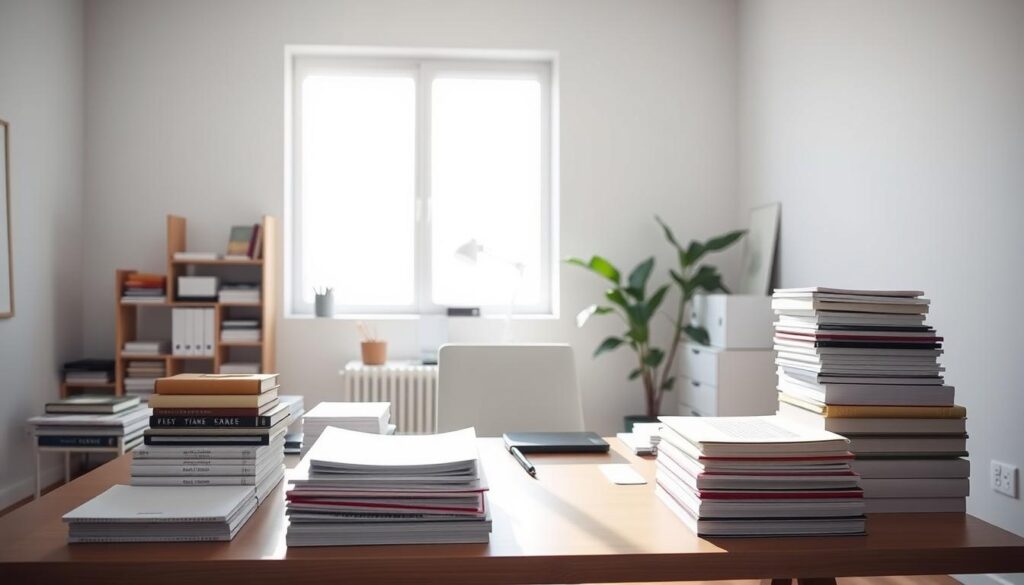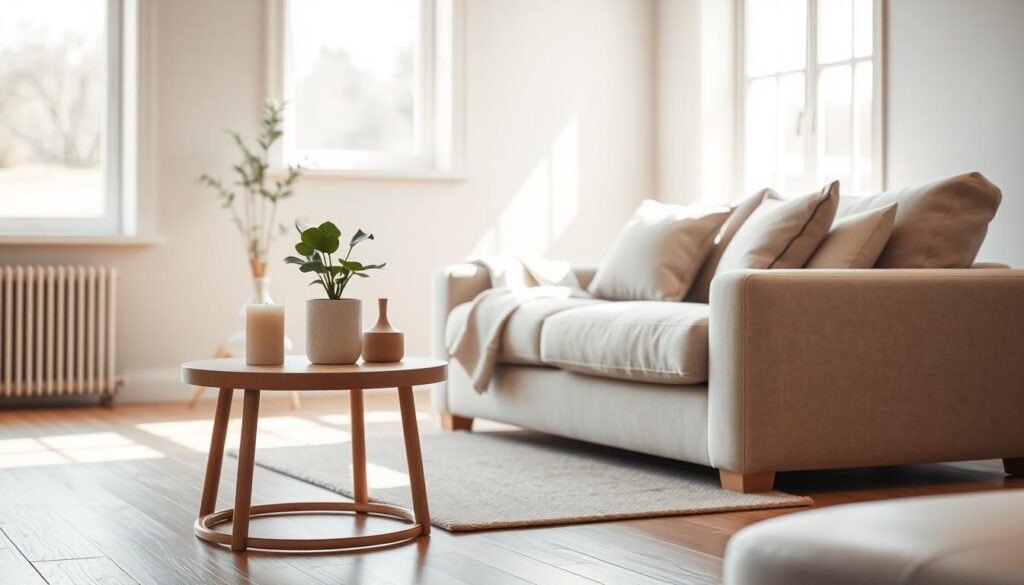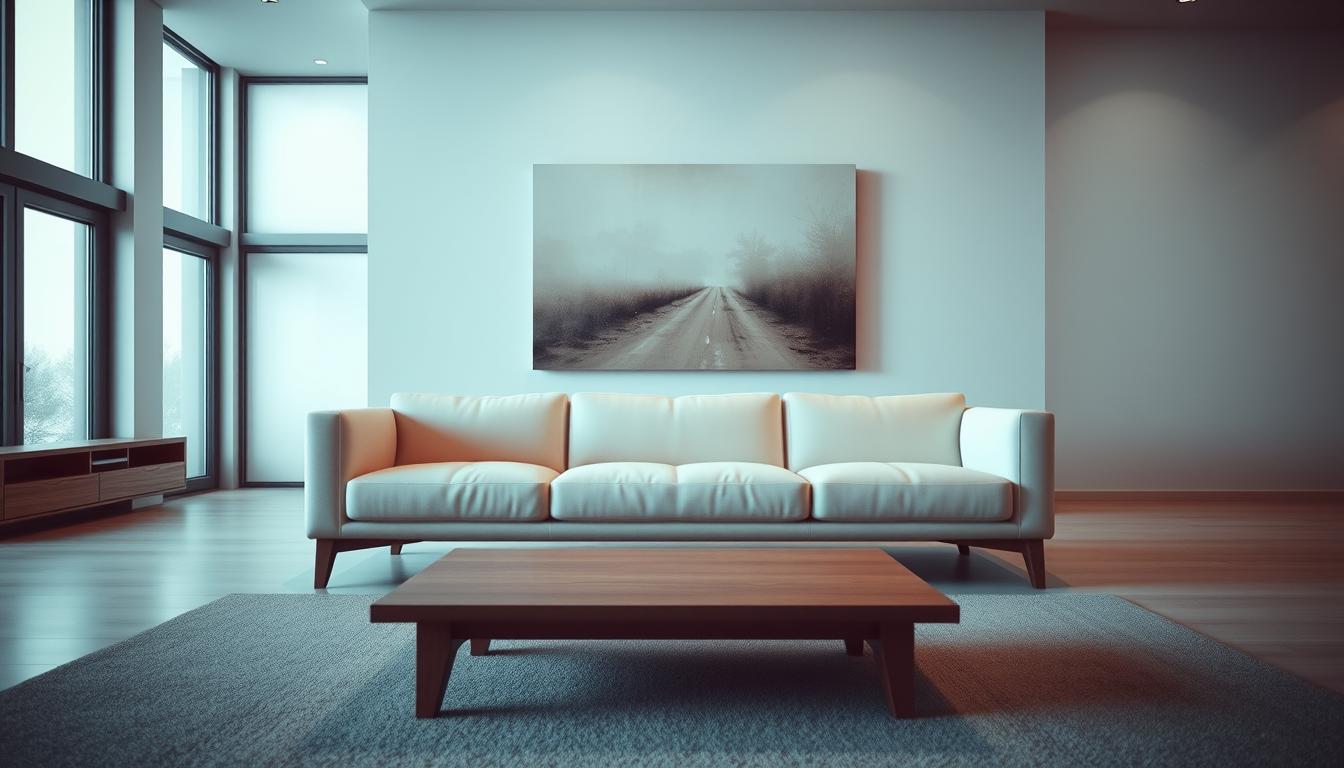Did you know that embracing minimalist decor can turn your home into a peaceful haven? It simplifies your space, bringing calm and clarity in our busy lives.
Minimalist home decor is more than just tidying up. It’s a choice that focuses on clean lines, simplicity, and fewer colors. This approach makes your home stylish and peaceful, helping you relax and feel better.
In this article, we’ll dive into the perks of minimalist decor. We’ll also share easy tips to bring it into your minimalism homes decor done right.
Key Takeaways
- Understand the principles of minimalist decor
- Learn how to simplify your space effectively
- Discover the benefits of a minimalist aesthetic
- Get practical tips on implementing minimalist decor
- Create a serene and stylish living environment
Understanding Minimalism in Home Decor
Minimalist design makes living spaces both useful and lovely. It’s a way of decorating that values simplicity and function. It goes beyond looks to bring calm and clarity.
What Is Minimalism?
Minimalism started in the early 20th century. It’s all about simplicity and removing what’s not needed. Minimalist living spaces have clean lines, little decoration, and a few colors. They are tidy and help us feel calm and focused.
Choosing minimalist home styling makes our homes look good and feel relaxing. It helps us work better too.
The Philosophy Behind Minimalist Design
Minimalist design believes simplicity leads to a cleaner, more meaningful life. It’s about picking items that matter or make us happy. Minimalistic design helps us think about what’s truly important to us.
Embracing minimalism makes our homes beautiful and true to who we are. It also improves our well-being.
Benefits of Minimalist Decor
Minimalist home decor has many advantages. It makes our homes feel bigger and brighter. It also helps us live more eco-friendly. By keeping things simple, we make our homes peaceful and useful.
Enhancing Space and Light
One big plus of minimalist decor is how it makes rooms look bigger and brighter. By cutting down on clutter and using light colors, we let more natural light in. This is super helpful in small homes or apartments.
Reducing Clutter for Mental Clarity
Minimalist decor is not just about looks. It also helps us stay organized and calm. By keeping only what we really need, we clear our minds. This is great in today’s busy world.
Eco-Friendly Living
Choosing minimalist decor also helps the planet. We can pick furniture and decor that are good for the earth. This means choosing items made from natural or recycled materials. Plus, buying less helps us live more sustainably.
In short, minimalist decor is good for our homes and our minds. It makes our spaces beautiful, calm, and green. By going for minimalist decor, we improve our living spaces and our lives.
Key Principles of Minimalist Design
Minimalist design is about removing the unnecessary to show a simpler, more efficient way of living. “Minimalism is not just about having less; it’s about making room for what’s truly important,” many say.
Looking into minimalist design, we see key elements. One main point is functionality over ornamentation. This means every item in a minimalist space should have a purpose, cutting down on clutter and extra decoration.
Functionality Over Ornamentation
In minimalist design, we focus on clean lines, simple shapes, and no clutter. It doesn’t mean the space lacks character. Instead, the character comes from the design’s functionality and simplicity. For example, a storage ottoman is useful for more than one thing, so you don’t need extra pieces.
Color Palette Choice
Choosing the right color palette is also key in minimalist design. Spaces often use a few colors to feel calm and unified. Neutrals like whites, grays, and blacks are common because they provide a clean base for the space. “A simple color palette is not just pretty; it also brings peace,” says a top interior designer.
Accent colors can be used sparingly to add interest. But the main colors stay simple. This color choice makes the space look good and supports the minimalist idea of simplicity.
Multi-Functional Furniture
Choosing multi-functional furniture is another important part of minimalist design. Furniture that does more than one thing is valued for reducing clutter and making the space more useful. For instance, a desk with storage or a sofa bed can be very useful in a minimalist home.
By following these principles, we can make spaces that are not just pretty but also practical and cozy. As we dive deeper into minimalist design, we see its benefits go beyond looks to a more streamlined, efficient life.
Finding the Right Pieces for Minimalism
Minimalism is about being careful with every item in our home. It’s about making a space that looks good and works well. To do this, we need to pick the right furniture, add minimalist art, and choose our textiles carefully.
Selecting Essential Furniture
Furniture is key in minimalist home styling. We should pick pieces that are both useful and look good. For more tips on minimalist homes, check out a guide to creating a minimalist home.
- Choose furniture that can do more than one thing to cut down on clutter.
- Look for furniture with simple designs and no extra decorations.
- Make sure the furniture fits well in the room.
Minimalist design experts say “Less is more.” This helps us choose furniture that has a purpose and looks good in our space.
“The best way to get started is to start.” This quote shows the mindset we need to start our minimalist journey, including picking the right furniture.
Incorporating Minimalist Art
Minimalist art can make our home look elegant without making it messy. When picking art, look for pieces that are simple but powerful.
| Art Type | Characteristics | Benefits |
|---|---|---|
| Abstract | Simple forms, limited color palette | Adds visual interest without clutter |
| Line Art | Clean lines, minimal shading | Creates a sense of calm and simplicity |
| Photography | Simple compositions, natural subjects | Brings the outdoors in, enhances serenity |
Choosing Textiles Wisely
Textiles are important in minimalist decor. They add warmth and texture without making the space messy. For minimalist decor tips, think about the color, texture, and use of textiles.
For help in making our home minimalist, we can look at minimalist home staging services. They offer expert advice on styling our home.
When picking textiles, we should:
- Choose natural fibers like cotton, linen, and wool.
- Stick to a few colors to keep things cohesive.
- Think about the texture and how it feels in the room.
By being careful with our choices, we can make a minimalist home that’s stylish and peaceful.
Color Schemes for Minimalist Homes
A good color scheme is key to minimalist design. It sets the mood for the whole space. This creates a calm and cohesive atmosphere, typical of minimalist homes.
Neutral Tones
Neutral tones are essential in minimalist color schemes. Shades like white, beige, and gray are common. They make the space clean and peaceful.
Neutral tones also make rooms look bigger. They help keep the space simple, letting the eye move easily.
Accent Colors
Neutral tones are the base, but accent colors add depth. Used carefully, they highlight certain parts of the room or create a focal point.
Choosing the right accent colors is crucial. Earth tones, like terracotta or sage green, are great. They add warmth without overwhelming the space.
The Power of White Space
White space is vital in minimalist design. It’s the empty space around objects, creating calm and clarity.
Using white space well means balancing filled and empty areas. This balance is essential for a peaceful and harmonious space.
Decluttering: The First Step to Minimalism
Decluttering is the first step to achieving a minimalist decor. It involves removing items we don’t need from our homes. This makes our living spaces cleaner and more organized.
By doing this, we focus on what’s truly important. It also makes our homes look better and helps us think more clearly.
Tips to Start Decluttering
To start decluttering, we need a plan. Begin with one area, like a shelf or drawer. Sort items into keep, donate, sell, or discard piles.
Be honest with yourself about what you really need or enjoy. Letting go of unnecessary items is key.
Begin with the easy wins: Clear off countertops and sort through any clutter. This can make a big difference in how a room feels.

Organizing Techniques We Can Use
After decluttering, we need to organize what’s left. Using good organizing techniques helps keep our homes clutter-free. Choose storage solutions that look good and work well, like baskets and bins.
- Use vertical space by installing shelves or storage units that go up to the ceiling.
- Implement a “one in, one out” policy to prevent clutter from building up again.
- Keep frequently used items accessible and store less frequently used items in labeled containers.
By following these tips, we can make our homes beautiful and peaceful. The secret to keeping a minimalist decor is to be mindful of what we buy. Regularly check if our belongings still bring us joy or serve a purpose.
The Role of Natural Light
Natural light is key in minimalist home design. It makes rooms feel bigger and more welcoming. It lights up the space and highlights the decor’s colors and textures.
To get the most from natural light, it’s important to know how to use it well. Maximizing natural light means placing mirrors right, choosing the right window treatments, and keeping things tidy. This lets light move freely.
Maximizing Natural Light
Using mirrors opposite windows is a smart way to brighten a room. It makes the space look bigger. For more tips on light and space in minimalist design, check out our blog post.
Also, keep windows clear of heavy drapes or clutter. This lets natural light in freely, making the room feel brighter and airier.
Window Treatments for Minimalism
Minimalist homes often choose simple window treatments that let light through. Sheer curtains or blinds are favorites because they offer privacy and let sunlight in.
For a modern touch, roller shades or drapes in neutral colors work well. They fit the minimalist style and help control light.
In summary, natural light is essential in minimalist decor. It adds openness and calm. By using light wisely and picking the right window treatments, homes become bright and inviting, true to minimalist values.
Textures and Materials in Minimalist Decor
Textures and materials are key in minimalist design. They add depth and character to a room. Choosing them wisely makes a minimalist space feel welcoming and interesting.
Choosing Natural Materials
Natural materials are at the heart of minimalist decor. They bring warmth and authenticity, balancing out minimalism’s coldness. Wood, stone, and linen are great for texture and depth. They make a space visually appealing and inviting to touch.
When picking natural materials, think about their origin and sustainability. Reclaimed wood, for example, adds character and tells a story. It makes the space more emotionally connected. Natural fibers like wool and cotton also warm up a minimalist room.
Mixing Textures for Interest
Mixing textures adds interest to a minimalist space. Combining smooth and rough textures creates a layered look. For instance, marble’s smoothness paired with exposed brick’s roughness adds depth and complexity.
- Combine different textures like wood, metal, and fabric for a layered look.
- Use natural fibers like wool and cotton for warmth.
- Add natural elements like stone and plants for texture and interest.
By carefully choosing and mixing textures and materials, you can make a minimalist space beautiful and engaging. The goal is to balance different elements. This keeps the space calm and uncluttered yet visually interesting.
Personalizing Minimalist Spaces
Minimalism doesn’t mean your space can’t feel personal. It’s about adding touches that make it uniquely yours. It’s finding the right mix of simplicity and character.
Strategically Placed Accessories
Accessories are key in making a minimalist space feel personal. Pick a few meaningful items that add interest without clutter. Here are some tips:
- Choose items that have personal significance or sentimental value.
- Opt for simple, clean-lined designs that complement the minimalist aesthetic.
- Limit the number of accessories to avoid clutter and maintain a sense of calm.
Consider vases, sculptures, or art pieces that speak to you. The goal is to add personality without overwhelming the space.

Using Plants to Add Life
Plants are great for adding life and personality to a minimalist space. They purify the air, improve ambiance, and add a natural touch. This can soften the space’s clean lines.
When picking plants, keep these tips in mind:
- Select plants with simple, elegant shapes that complement the minimalist aesthetic.
- Choose low-maintenance plants that are easy to care for, such as succulents or air plants.
- Use planters that are simple and understated to avoid adding clutter.
By adding plants and carefully chosen accessories, you can make a minimalist space feel personal and welcoming. The key is to balance simplicity with personal touches.
Creating a Cohesive Look
A cohesive look is key to minimalist decor, making a space calm and stylish. It’s about making sure every part of the space works well together.
To get this, we focus on two main things: keeping things consistent and balanced. Let’s see how we can do this.
Maintaining Consistency
Consistency is vital in minimalist design. It means picking a few main things, like colors or furniture styles, and using them everywhere. This creates a smooth flow and a sense of unity.
For example, picking a neutral color scheme for all rooms can really help. Using similar textures and materials for furniture and decor also makes the space look more connected.
The Importance of Balance
Balance is just as crucial as it keeps the space from feeling too empty or too full. In minimalist design, balance is about placing visual elements carefully. This can be done with symmetrical or asymmetrical setups, depending on what you want.
Symmetrical balance means mirroring things on both sides of a central point, making the space feel stable and ordered. Asymmetrical balance uses different elements in a way that creates a lively and engaging space.
By keeping things consistent and balanced, we can make a space that looks good and feels peaceful. This not only makes our home look better but also makes it a more relaxing place to be.
Common Mistakes in Minimalist Decor
Creating a minimalist home can be tricky. We often make mistakes that can be avoided. These errors can make our simple, functional space complicated.
Keeping things simple yet functional is a big challenge. When done right, minimalist decor makes our homes look better and feel comfortable.
Over-Complicating Spaces
A common mistake is making spaces too busy with too many items or complex designs. Minimalism is about simplicity. Too many accessories or patterns can ruin this.
To fix this, we should use clean lines, simple shapes, and a few colors. This makes our space look better and feel calm.
Neglecting Functionality
Another big mistake is forgetting about function for the sake of looks. Minimalist decor is about simplicity, but the space must also be useful and comfy.
To get it right, we should choose furniture that does more than one thing. This keeps our space minimalist and still livable.
Resources for Minimalism Inspiration
To stay motivated and inspired on your minimalist journey, it’s key to have the right resources. We can find inspiration from many online platforms and blogs. They showcase stunning minimalist designs.
Online Platforms and Blogs
Websites like Dezeen and Apartment Therapy are full of info on minimalist decor. They offer design tips and product recommendations. These online resources help us create a stylish and cohesive space.
Books on Minimalist Design
For a deeper dive, books on minimalist design are great. Titles like “The Joy of Less” by Francine Jay and “Minimalism: Live a Meaningful Life” offer practical advice. They help us make informed decisions about our home decor.
By using these resources, we can deepen our understanding of minimalist design. We can stay inspired to create a more streamlined and beautiful home.


